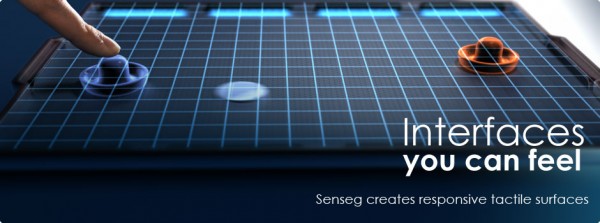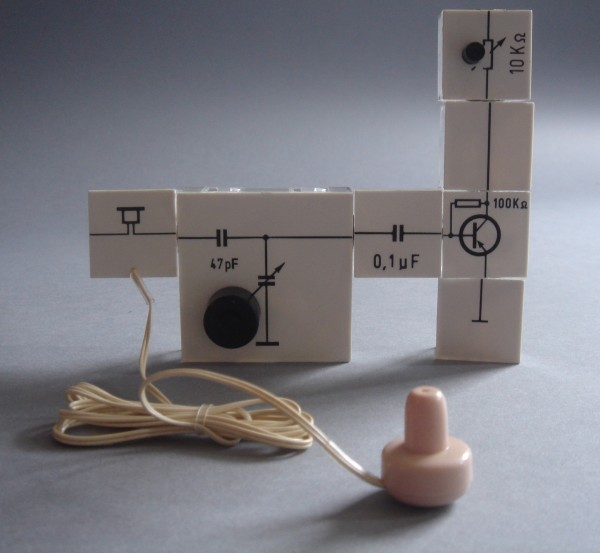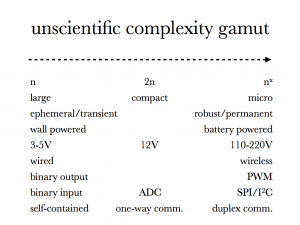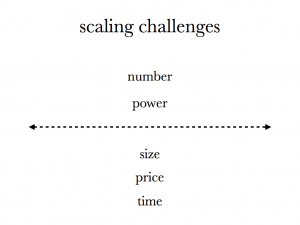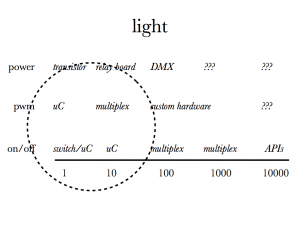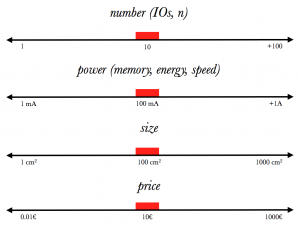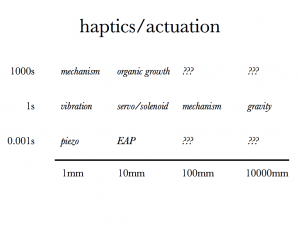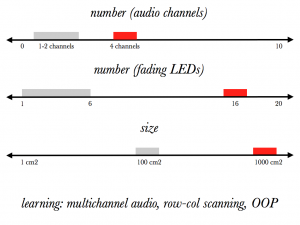Bits and pieces of December 2011
Mitsubishi Electric’s EMIRAI concept car interface, link
Introduction of shape changing buttons. Not exactly ground breaking, but it’s nice to see it being pushed toward mainstream.
Feel Screens from Senseg, link, video
By passing an ultra-low electrical current into the insulated electrode, Senseg’s Tixel™, the proprietary charge driver can create a small attractive force to finger skin. By modulating this attractive force a variety of sensations can be generated, from textured surfaces and edges to vibrations and more.
The Braille-It Labeler from MIT, link
Very interesting Blind-Lead Technology Initiative from MIT. A sure keeper for resources on making (simple) tech for blind people.
NOWNESS, link
Performance Artist Christine Sun Kim explores sonic media without the benefit of hearing. She finds how to make its presence more physical, to find greater dimensions of movement, and to make a personal connection beyond what most of us might find in the everyday sense. As she describes it to NOWNESS.
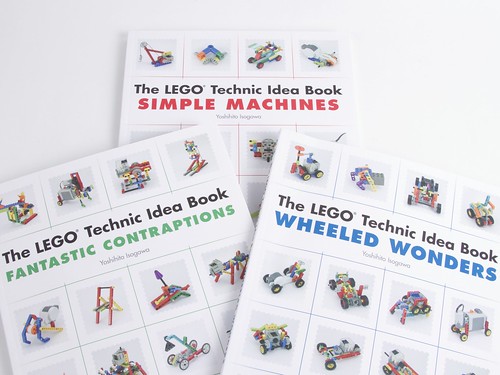
Lego Technic Idea Books: Fantastic Contraptions, Simple Machines, and Wheeled Wonders
This seems like an inspiring example of documenting mechanical contraptions and tangible project builds. I just ordered the three books, and can’t wait to explore them! Found via Evil Mad Scientist Laboratories.
CS277 – Experimental Haptics course at Stanford, link
Good educational resources + lectures for intro to haptics, from a CS perspective.
Workshop at Haptics Symposium 2012
Things will be busy but very exciting at the end of winter next year. Right after TEI 2012, I will be heading to Vancouver for the Haptics Symposium conference. The program and activities look amazing, and it celebrates 20 years of multidisciplinary research relating to the human sense of touch.
I am very fortunate to be part of a Panel Workshop organized by John Morrell. The title of the session is Tools and Techniques for Prototyping Haptic Interfaces.The other tutorial/workshop sessions look super interesting too. A very promising trip to Canada indeed!
Bits and pieces of November 2011
How to Make Fake Buttons Feel Real, link
MIT Technology review from researchers in Tampere, Finland, highlights that users prefer virtual buttons that have real-world buttons characteristics.
Haptic feedback design guidelines from Nokia, link
Nice table showing tactile feedback effects name + description. It also suggests how haptic feedback fits in multimodal notifications.
FingerFlux: Near-surface Haptic Feedback on Tabletops, from Media Computing Group at Aachen university, link
Presented at UIST’11.

Haptic Intelligentsia, Bringing Craftsmanship Into a Computerized Technology, from Joong Han Lee, link
Haptic interfaces presentation from Katherine J. Kuchenbecker, UPenn page
Haptic Hand Prototype – pluck pinch and scrub, youtube video
Prototype with a motorized slider to pluck a string model in PD.
The Beginner’s PID and Arduino PID Library, link
A very thorough introduction to PID control with Arduino. Nice details about loop speed and interrupts.
Designing Haptics in Mobile Applications
Join David Birnbaum, Immersion’s senior user experience researcher, for a discussion of what makes a compelling haptic experience and how to create one for your product.
Designing Haptics Studio at TEI 2012
Yippi, my Studio proposal for TEI 2012 has been accepted! I will be running this day long workshop with Stoffel Kuenen, PhD student at UID, and Ali Israr from Disney Research. The Studio program is pretty exciting this year, it’s great to be part of it. Here is the abstract for our Studio:
This studio proposes to tangibly explore the world of haptics to develop a greater understanding and sensitivity to this emerging field. The first part of the studio focuses on general knowledge about haptics, haptic and multimodal perception in humans, and key advances in actuator and sensor technologies to develop haptic interfaces. Numerous demos and testing platforms will be available to relate discussions with real haptic sensations. The second part of the studio aims to explore the various challenges and difficulties in designing haptic interfaces by directly building and sketching in hardware haptic interfaces. Participants will be invited to build their own haptic interfaces from various actuators, sensors and other building blocks. The studio aims to bridge the fields of haptics and design, and investigate various prototyping tools and approaches that can best support haptic design activities.
The Studio is limited to 20 participants and is free for all attendees, so register quick :-)
Bits and pieces of October 2011
ShapeShift, electro-active polymer (EAP) explorations, link
ShapeShift is an experiment in future possibilities of architectural materialization. This project explores the potential application of electro-active polymer (EAP) at an architectural scale. EAP offers a new relationship to built space through its unique combination of qualities. It is an ultra-lightweight, flexible material with the ability to change shape without the need for mechanical actuators. As a collaboration between the chair for Computer Aided Architectural Design (ETHZ) and the Swiss Federal Laboratories for Materials Science and Technology (EMPA), ShapeShift bridges gaps between advanced techniques in architectural design/fabrication and material science as well as pushing academic research towards real world applications.
Surface Transducer available from Sparkfun, link
Haptics Technologies: Bringing Touch to Multimedia, book, link
Series: Springer Series on Touch and Haptic Systems, El Saddik, A., Orozco, M., Eid, M., Cha, J. 1st Edition., 2011, XV, 218 p. 87 illus.
This book is different from any other book that has looked at haptics. The authors treat haptics as a new medium rather than just a domain within one of the above areas. They describe human haptic perception and interfaces and present fundamentals in haptic rendering and modeling in virtual environments. Diverse software architectures for standalone and networked haptic systems are explained, and the authors demonstrate the vast application spectrum of this emerging technology along with its accompanying trends. The primary objective is to provide a comprehensive overview and a practical understanding of haptic technologies. An appreciation of the close relationship between the wide range of disciplines that constitute a haptic system is a key principle towards being able to build successful collaborative haptic environments.
What is Haptics? from Texas Instruments (TI), part 1, part 2
The DRV8662EVM Evaluation Module (EVM) is a fully-differential, high-voltage piezo actuator driver that provides quick response time for single layer and multi-layer piezo actuators. The DRV8662 drives piezo loads up to 200V differentially using an adjustable integrated boost converter. The evaluation module contains the DRV8662 piezo haptics driver, a programmable MSP430, and passive components for complete evaluation.Evaluation board available for 99 USD at http://www.ti.com/drv8662evm-pr
iOS 5.0 Custom Vibration Alert
iOS 5 Features: Vibration Patterns. Haptics (although quite basic) slowly making their way into mainstream products!
Bits and pieces of September 2011
Synaptics Fuse Mobile Phone Concept, link and video
Old news from 2010, but still interesting as a concept piece. The Fuse mobile phone concept is a collaboration among Synaptics, Texas Instruments (TI), Immersion, TheAlloy, and TAT – The Astonishing Tribe. The device solves key human interface challenges for current-generation handsets, primarily single-handed usage.
AHNE – Audio-Haptic Navigation Environment, Sound and Physical Interaction from Helsinki, link
It is an audio-haptic user interface that allows the user to locate and manipulate sound objects in 3d space with the help of audio-haptic feedback.The user is tracked with a Kinect sensor using the OpenNI framework and OSCeleton.The user wears a glove that is embedded with sensors and a small vibration motor for the haptic feedback.
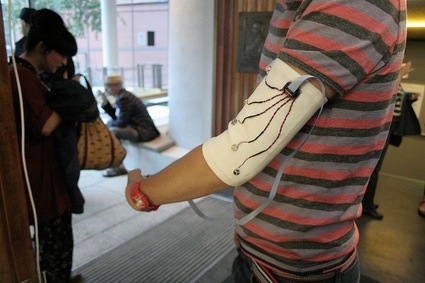
Sticky Data device from The Institute for Boundary Interactions, link
The most stimulating thing about being able to sense geo-located data is the thought that you are physically feeling traces of people’s experiences in the same place where they happened. We think this gives an extra sense of connection to a place, even if only for a moment. [text blurb and image from We Make Money Not Art]
Glove to improve sense of touch, from Georgia Tech, link
Previous research has shown that adding an appropriate amount of white noise — a concept called stochastic resonance — can improve sight, hearing, balance control and touch, but the white noise had not been incorporated into a wearable device. The Georgia Tech prototype is believed to be the first wearable stochastic resonance device, attaching to the fingertip to improve the sense of touch.
Quanser High Definition Haptic Device, link
Haptic devices use high bandwidth servo motors and encoder feedback to simulate real-life situations like surgery. (Another case of “refining haptics via technological advances”, not bad necessarily)
Simulating The Sensation Of An Object Passing Through Your Hands, link and video
The Kajimoto research group at the University of Electro-Communications is developing a device that simulates the sensation of something passing through your hand. It is proposed to improve the sense of realism in games, and uses a vibration mechanism to create the illusion.
Bits and pieces of August 2011, more
Braun Lectron System, link, from MOMA exhibition Talk to Me.
Dieter Rams and Jurgen Greubel designed the Braun Lectron System (1967- 69) as a teaching tool for use in schools and universities. It is made up of a large range of little bricks, like dominoes, that magnetically connect to one another. Once the blocks are organized on a conductive plate, they can form a variety of functional circuits. See this link for an expanded text on the Lectron kits. Thanks Stoffel for sharing this from your notes.
Why design is key in haptics innovation, link
“importance of design–and design-thinking–in haptics and other areas of engineering”. Katherine J. Kuchenbecker is heading the Haptics Group at University of Pennsylvania. Nice projects and course MEAM 625: Haptic Interfaces.
CRAVE duet, link
A vibrator for women that is portable, compact and elegant. Nice product design prototypes involving haptics. Thanks Nadine for the link!
Haptic computer interface, link
Scientific American’s Patent Watch. Interesting to see haptics reaching general interest. Thanks Lorenzo for the link.
Tacit: Sonar for the blind, link
Bits and pieces of August 2011
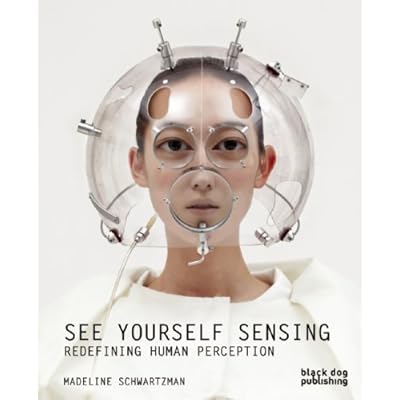
See Yourself Sensing: Redefining Human Perception, link
See Yourself Sensing: Redefining Human Perception is the first book to survey the fascinating relationship between design, the body, science and the senses. Over the last 50 years, artists, architects and designers have been experimenting with the boundaries of our senses, altering the way we experience the world.
HAPMAP, link and video
A pedestrian navigation system, with a natural and intuitive haptic interface, providing subtle and complex navigation cues following the curvature of a road or path. Yuki Imamura from Keio University, Emerging Technologies @ SIGGRAPH 2011.
Surround Haptics, link
Surround Haptics is a new tactile technology that allows generation of high-resolution, continuous, moving tactile sensations anywhere on the human body. The technology is inexpensive. It can be used with a broad range of off-the-shelf tactile actuators. It is compact. And it can easily be integrated into clothes, furniture, accessories, hand tools, mobile devices, and game accessories, among other potential applications. Disney Research, Emerging Technologies @ SIGGRAPH 2011.
Mommy Tummy, link
Mommy Tummy is an interactive system that simulates pregnancy. A user wearing the Mommy Tummy jacket can feel the fetus’s temperature, movement, and heartbeat, and, by rubbing the jacket, communicate with the fetus. Within a few minutes, the jacket’s weight and size change, simulating fetal growth over nine months. Kanagawa Institute of Technology (Japan), Emerging Technologies @ SIGGRAPH 2011.
RolyPoly, link
RolyPoly enables two individuals to “sense” the presence of each other even though they may be physically apart. This is achieved through the mirrored movements in a pair of RolyPolys. A gentle tap to rock one RolyPoly simultaneously rocks its partner RolyPoly to the same degree. Likewise, a sudden shake and rattle in one instantly produces a corresponding reaction in the other. Kanagawa Institute of Technology (Japan), Emerging Technologies @ SIGGRAPH 2011.
Serial Latency on Arduino and Teensy, link
Java latency is at least 20ms, The Arduino UNO may be slower than the Arduino 2009 if small a amount of serial bytes (<12b) are transferred, The Teensy 2.0 board may be up to 18 times faster than an Arduino board. Discussion on Arduino forum.
Sketching in Hardware 2011

Last week, I attended Sketching in Hardware 2011 in Philadelphia (USA) and it was super interesting. I missed last year’s edition, so I was happy to be able to participate in this year’s gathering.
Sketching in Hardware is an annual summit on design and use of physical computing toolkits. The summit invites toolkits developers, educators and makers to discuss about prototyping in the realm of hardware + software electronic toolkits.
I decided to present my thoughts and some insights related to scaling issues in hardware sketching that I’ve been observing while teaching at UID over the last 5 years. I titled my presentation “Extreme Interactions”, knowing it can be interpreted in many ways. In this presentation, extreme means beyond the common, outside of your comfort zone. In typical Physical Computing classes, students learn basic electronics and how to interface hardware with software. The baseline activities often revolve around Arduino, with a few sensors, some LEDs or servos, and maybe a specialized module or shield. What I wanted to convey in my presentation is that the world of physical computing is much larger than that, and intentionally exploring different scales (size, power, number, etc) can be very beneficial for learning. The various orders of magnitude are also nice learning vectors to plan, build and reflect about limitations and prototyping activities.
I received good comments from participants and I will definitely try to evolve my thoughts on these scaling issues. I use the Powers of Ten reference to support the exploration of various scales. Maybe the analogy is not right, but I like the similarity with the physical computing domain and the educational endeavors: humans/designers know mostly about human-scale and common issues, anything larger or smaller is tackle by experts. Exploring new domains, pushing boundaries and learning from problems and failures is intellectually stimulating and rewarding.
My presentation is available for download in PDF format: 2011.extreme.interactions.v2.pdf. Be sure to check the Sketching11.com website for all the presentations later this month.
Bits and pieces of July 2011
The Art & Science of Touch
In this video, artist and jewelry designer Farah Bandookwala uses Haptics (via Cloud 9, a 3D touch-modeling software) to design her works. It is not the first I hear about the Cloud 9 software, I should try it out with my Falcon eventually. [via Ponoko]
Artificial Muscle: Designing for Haptics, link
Kicker Studio, published a small case study about work exploring haptics. After reading the article, I find it a bit superficial. It is mostly about enhancing UX touchscreen products with vibrotactile feedback. The thing I appreciate the most with the write-up is the importance of building prototypes to feel haptics during the design work. As I’ve been finding myself, haptics is best multimodal (haptic + sound effect = believability) and the timing is crucial to get things right.
Immersion’s Haptic Design Guidelines, link
I have been exploring and playing a bit with Immersion’s new SDK for Android called MOTIV. I appreciated the Universal Haptic Layer (UHL) available as a list of 100+ predefined haptic effects. I tried it on my HTC Nexus One, and it is a bit disappointing, it is mostly buzzing differently. I guess some new phone hardwares with LRA or piezo actuators provide enhanced haptic rendering capabilities. Immersion is providing a few guidelines for designing haptic effects, with good insights about timing and considerations for various type of actuators. I’ll definetely continue exploring MOTIV Studio, their development tool to draw and build haptic effects.
Four Stages of Competence
I am trying to dig into a bit of psychology these days to mostly learn about learning processes and learning styles. Only key model that I recently found is the “conscious competence” learning model [wikipedia]. It has four main stages: Unconscious Incompetence, Conscious Incompetence, Conscious Competence and Unconscious Competence. There is often a fifth stage added to the model. The best resource for introducing and explaining it this page at Businessballs.

